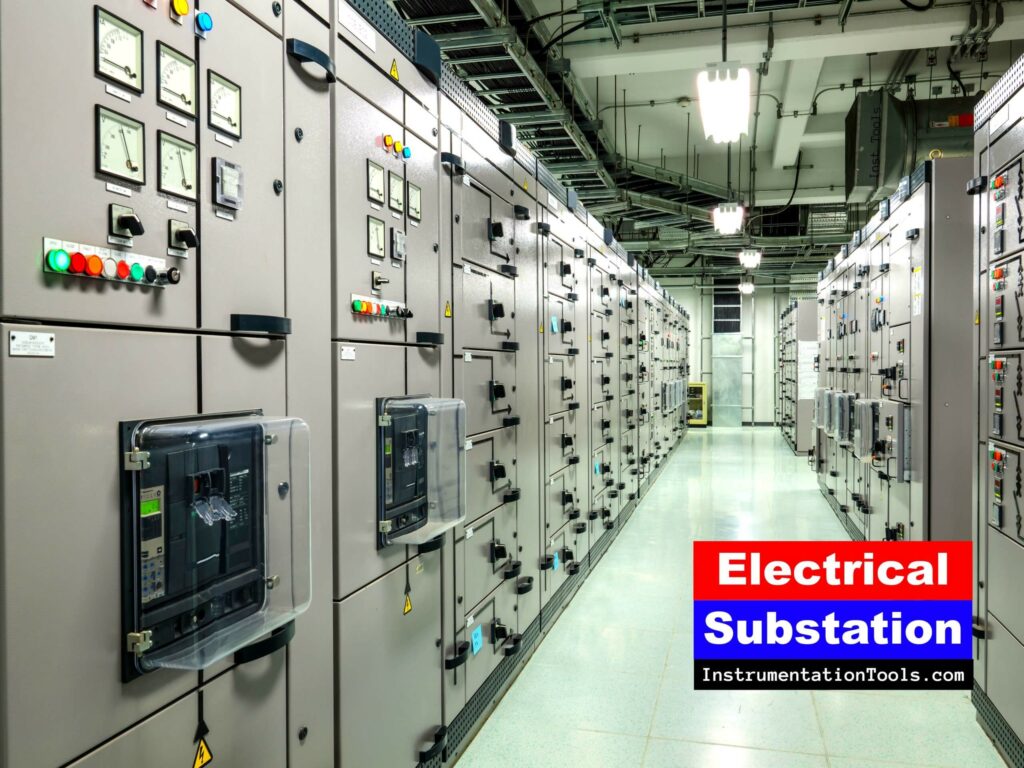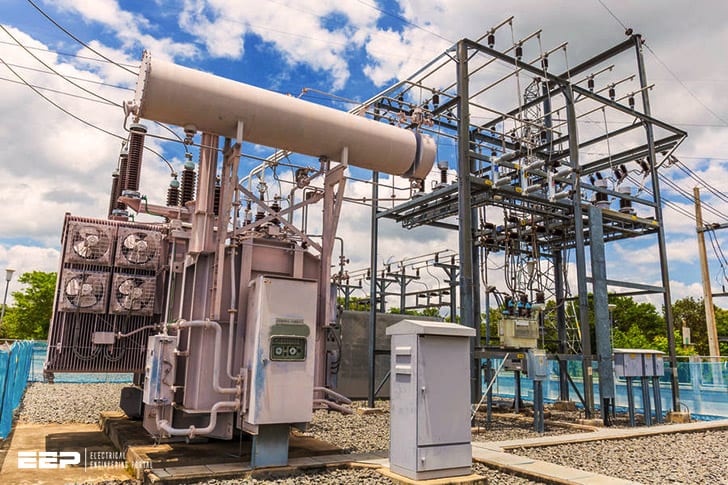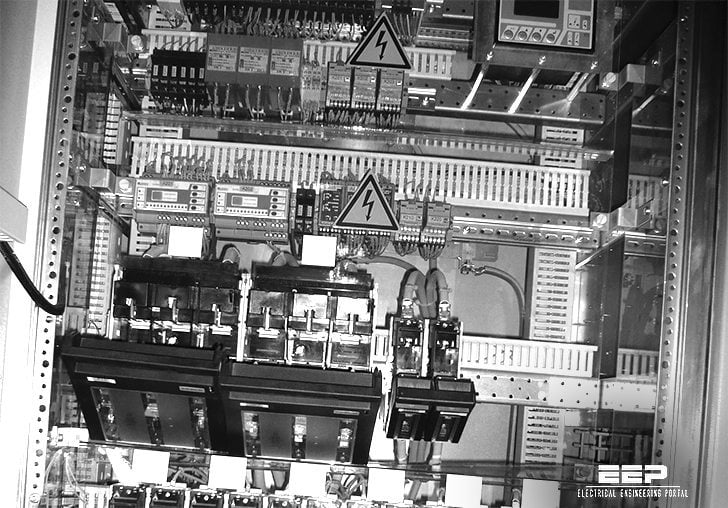1. What is a substation?
2. What are the different types of substations?
3. How do you select a particular type of substation for a given application?
4. What are the main components of a substation?
5. Explain the function of each main component in a substation.
6. How does voltage transform from one level to another in a substation?
7.What is the purpose of earthing in a substation?
8.How is power transmitted from a substation?
A substation is an electrical installation where equipment is used to change the voltage and current characteristics of an electric power system.
. There are three common types of Substations- Transmission, Distribution, and Service or Industrial Substations . The selection process for determining which type of Substation to use depends on factors such as system voltage levels, anticipated load growth, cost , appearance, safety ,and maintenance considerations .
The key components inside most Substations include Circuit Breakers ,Transformers ,Capacitors ,Busbars , Isolators and Earthing Systems . Circuit breakers interrupt the flow of electricity while Transformers convert voltages from high to low or vice versa . Capacitors store energy while busbars conduct electricity between two points .
Isolators prevent short circuits and Earthing systems provide electrical grounding .
Top-10 Technical interview questions on HT(Sub-station) side.
1. What is a substation?
A substation is an electrical installation where voltage is transformed from one value to another, usually between 11kV and 400kV. A typical substation will contain power transformers, circuit breakers, switchgear, and other equipment.
2. What are the main components of a substation?
The main components of a substation are the power transformers, circuit breakers, switchgear, and associated equipment such as metering and protection devices.
3. Why do we need substations?
Substations are necessary to step down the high voltages transmitted over long distances to lower voltages suitable for local distribution. They also provide switching and protection for local distribution networks.
4. How do you protect against faults in a substation?
There are many ways to protect against faults in a substation including circuit breakers, fuses, reclosers, and ground grids.
Substation Electrician Test Questions
Are you considering a career as a substation electrician? If so, you’ll need to pass an electrician test in order to be certified. Here are some sample questions that you may encounter on the exam:
1. What is the primary function of a substation?
2. What are the three main types of equipment found in a substation?
3. Explain the difference between high voltage and low voltage transmission lines.
4. Describe the basic operation of a transformer.
5. How is DC power generated in a substation?
Power System Interview Questions
1. What is the most important thing to know about power systems?
The most important thing to know about power systems is that they are extremely complex. There are many different types of power systems, and each one has its own unique set of characteristics.
As a result, it is very important to have a strong understanding of power system fundamentals before attempting to answer any questions about them.
2. What are the three main components of a power system?
The three main components of a power system are the generating units, the transmission lines, and the distribution network.
Generating units produce the electricity that flows through the system, while transmission lines carry this electricity from place to place. The distribution network then delivers this electricity to consumers.
3. How do generating units produce electricity?
There are several different ways that generating units can produce electricity, but all methods involve converting some form of energy into electrical energy. Common sources of energy include coal, natural gas, nuclear fuel, solar radiation, and wind.
Transformer Interview Questions
1. What is a transformer and how does it work?
2. What are the benefits of using a transformer?
3. How can I select the right transformer for my application?
4. What are the most common types of transformers?
5. How do I troubleshoot transformer problems?
What is Substation
A substation is an electrical installation where voltage is transformed from high to low, or the reverse. It usually consists of a large metal cage containing several devices such as transformers and circuit breakers. A substation may also include other equipment such as capacitors, reactors, and gas-insulated switchgear (GIS).
The word “substation” can also refer to the buildings housing these devices.
Substations are necessary because the voltage required by most consumers is much lower than that generated by power plants. For example, a power plant might generate electricity at 500 kV (kilo volts), but it would need to be reduced to 240 V for use in homes and businesses.
This reduction takes place in a substation.
The first step in reducing voltage is to use a device called a transformer. A transformer consists of two coils of wire wrapped around an iron core.
One coil is connected to the high-voltage side of the system while the other coil is connected to the low-voltage side. When electricity flows through the coils, it produces a magnetic field that turns the iron core into an electromagnet. This process induction causes electrons to flow through the secondary coil without any physical connection between the two coils.
The number of turns in each coil determines the ratio of primary voltage to secondary voltage; for example, if there are 100 turns in the primary coil and 50 turns in the secondary coil, then the secondary voltage will be half of the primary voltage.
After passing through a transformer, electricity enters a circuit breaker which protects against short circuits and overloads by automatically disconnecting circuits when current levels become too high. Circuit breakers are rated according to how much current they can safely interrupt; common ratings include 1 kA (kilo amperes), 3 kA, 6 kA, 10 kA, 15 kA, 20 kA, 25 kA ,and 30 kA .
From there ,the electricity flows into capacitors and reactors which help regulate current flow . Capacitors store energy temporarily while reactors limit or smooth currents . After passing through these devices ,the electricity finally reaches its destination where it powers homes ,businesses ,or other customers .
Substation Electrician Interview Questions
An electrician is a tradesman specializing in electrical wiring of buildings, stationary machines, and related equipment. Electricians may also specialize in wiring ships, airplanes, and other mobile platforms, as well as data and cable lines. Substation electricians install, maintain, test and repair distribution and transmission substations.
Substations are used to supply electricity from generators to distribution circuits. A typical substation includes a transformer for stepping down the voltage from the transmission line to a level that can be safely used by customers’ equipment.
What experience do you have working with high-voltage equipment?
How would you troubleshoot a problem with a circuit breaker?
What safety precautions do you take when working with electrical equipment?
How knowledgeable are you about the National Electrical Code?
What is your experience installing or repairing underground cables?
Electrical Engineering Interview Questions
As an electrical engineer, you will be responsible for designing, developing, testing, and supervising the manufacture of electrical equipment, including motors, radar and navigation systems, communications systems, and power generation equipment. You will also be involved in the development of electric vehicles, aircraft control systems, and GPS devices.
When interviewing for an electrical engineering position, you can expect to be asked questions about your experience with designing and developing electrical equipment.
You may also be asked questions about your experience with testing and supervising the manufacture of electrical equipment. Additionally, you may be asked questions about your involvement in the development of electric vehicles or aircraft control systems. Here are a few sample interview questions to help you prepare:
What experience do you have with designing and developing electrical equipment?
Can you tell me about a time when you had to troubleshoot an issue with electrical equipment?
What experience do you have with testing and manufacturing electrical equipment?
How would you go about designing a circuit?
What is your understanding of Ohm’s law?
Power Management Interview Questions
1. What is power management?
Power management refers to the process of managing the power consumption of electronic devices and systems. It includes both hardware and software components, and can be used to optimize performance or reduce energy consumption.
2. Why is power management important?
Power management is important because it can help improve the efficiency of electronic devices and systems, as well as reduce their energy consumption. When properly implemented, power management can help prolong the life of electronic devices by reducing wear and tear.
Additionally, power management can be used to improve the performance of devices by reducing heat generation and increasing processor speed.
3. What are some common power management techniques?
Some common power management techniques include clock gating, dynamic voltage scaling, and multiple supply voltage levels.
Clock gating is a technique that stops the clock signal from reaching certain logic gates when they are not needed, which reduces overall energy consumption. Dynamic voltage scaling adjusts the operating voltage of a device based on its current needs, which can also help save energy. Multiple supply voltage levels allow different parts of a system to operate at different voltages, which can further improve efficiency.
Power Factor Interview Questions
1) What is power factor?
Power factor is the ratio of real to apparent power in an AC electrical circuit. In other words, it’s a measure of how efficiently electricity is being used.
A higher power factor means less wasted energy and lower utility bills.
2) How can I improve my home’s power factor?
There are a few different ways to improve your home’s power factor, including: upgrading to more efficient appliances, using LED light bulbs, and investing in a whole-house surge protector.
You can also have your local utility company test your home’s power factor and help you make improvements.
3) Why is my business required to have a high power factor?
Many businesses are required to maintain a high power factor because it saves on energy costs and reduces demand on the electric grid.
A high power factor also helps prevent voltage fluctuations that can damage equipment.

Credit: www.youtube.com
What are 3 Roles of a Substation?
A substation is an electrical facility where voltage is transformed from high to low, or the reverse. Substations may be located indoors, outdoors, above ground, or underground. The three main roles of a substation are:
1) To take electricity from the transmission system and distribute it to consumers. This is done by using transformers to change the voltage so that it can be used by homes and businesses.
2) To provide a switchgear to connect and disconnect sections of the distribution system as needed.
This helps to minimize disruptions and outages.
3) To monitor and control the flow of electricity through the system so that it can be managed efficiently.
What are the Three Types of Substations?
There are three types of substations: power, distribution, and transmission.
Power substations are used to convert between different voltages of electricity, such as between alternating current (AC) and direct current (DC). They may also be used to change the frequency of the electricity.
Power substations are usually located near power plants.
Distribution substations distribute electricity from a high-voltage transmission line to a lower-voltage distribution line. They may also be used to change the voltage or frequency of the electricity.
Distribution substations are usually located near population centers.
Transmission substations transfer electricity from one high-voltage transmission line to another. Transmission substations are usually located away from population centers, in remote areas where there is less risk of damage to people or property if there were an accident at the substation.
What is the Most Important Thing in a Substation?
A substation is a critical part of the electric power grid. It is where high-voltage electricity from power plants is transformed into lower voltages for distribution to homes and businesses. substations also serve as key points for monitoring and controlling the flow of electricity in a power system.
The most important thing in a substation is safety. High-voltage electricity can be dangerous, and substations must be designed and operated with safety in mind. Other important factors in substation design include reliability, efficiency, and cost.
What is the Principle of Substation?
In an electric power system, a substation is a component of the network where voltage is transformed from high to low, or the reverse. The word substation comes from the days when electricity was generated at central stations and then distributed to users. Substations are now used in both generation and distribution systems.
In a generation system, substations transfer power from generating units to the main grid. In a distribution system, substations connect to feeders which distribute electricity to consumers.
A typical substation includes transformers which convert between high voltage and low voltage levels, switchgear for controlling power flows, circuit breakers for interrupting short circuits or overload currents, and busbars for collecting incoming voltages from outgoing ones.
Substations may also include monitoring and control equipment such as relays, telemetry equipment, protection devices like fuses or circuit breakers . Larger substations may have cooling towers to dissipate heat from transformers .
Conclusion
1. What is a substation?
A substation is an electrical facility where voltage is transformed from high to low, or the reverse, using transformers. Substations may also be used to switch circuits or regulate voltages.
These functions are typically performed by devices called circuit breakers, switches, and voltage regulators.
2. What are the different types of substations?
There are two main types of substations: transmission and distribution.
Transmission substations step down high-voltage electricity from power plants so it can be transported on lower-voltage power lines. Distribution substations then step down the voltage again so it can be safely delivered to homes and businesses.
3. How do you size a transformer for a substation?
The size of a transformer for a substation depends on the amount of power that needs to be transformed and the voltage levels involved.



